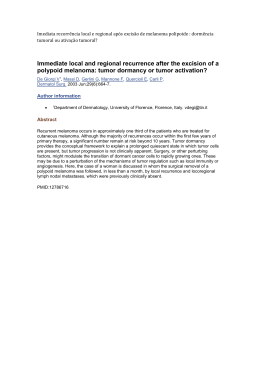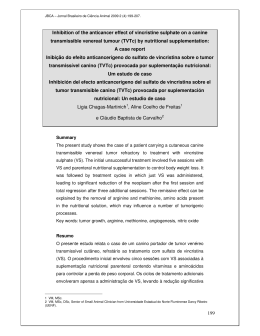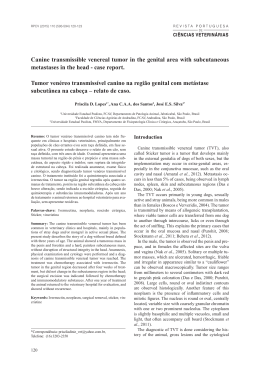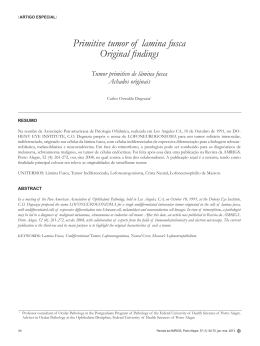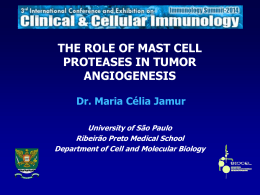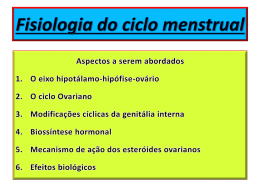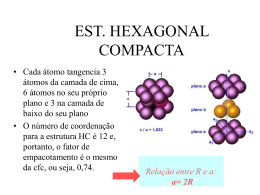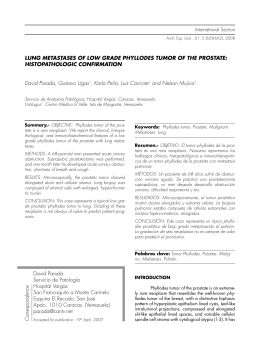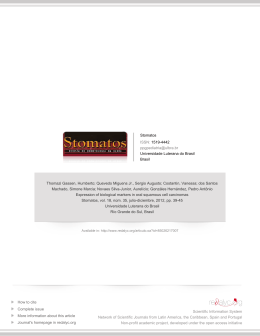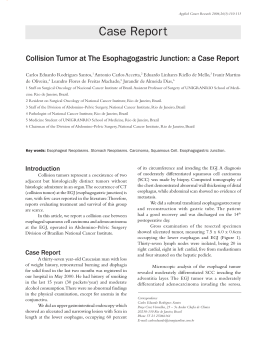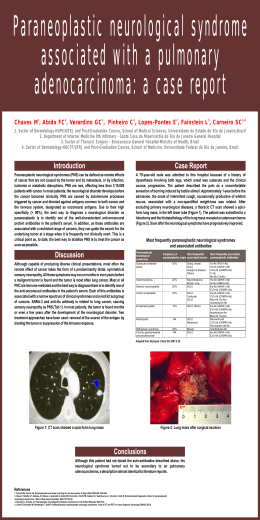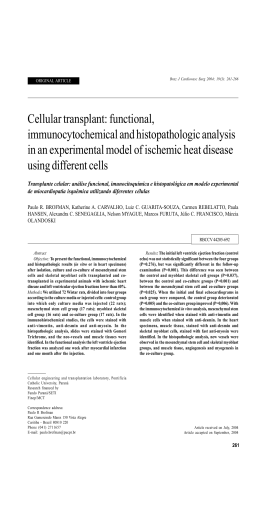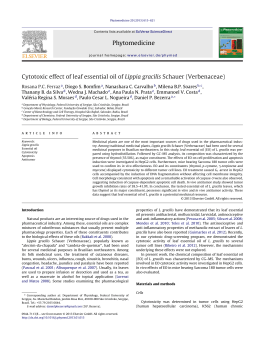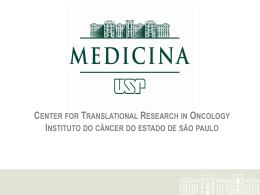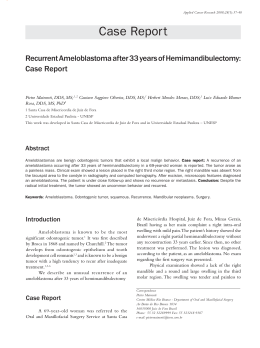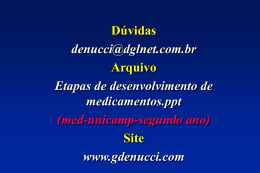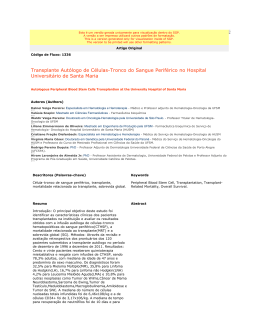The Physics in Biology Modeling Tumor Growth and Angiogenesis Rui Travasso Centro de Física Computacional Universidade de Coimbra Physics Today Mass galaxy 1040 black hole Sun 1031 1030 Earth 1024 Man G. Relativity ? Classical Mech. Material Properties Superconductivity Superfluidity Turbulence Chaos Life Consciousness Social Relations 100 Number of Particles dust 10-12 DNA 10-21 atoms 10-27 electrons 10-31 Quantum Mech. Physics in Biology Physics is needed Physical processes entangled with biology Tumor growth Embryonic development Consciousness Interdisciplinary subject Physics Biology Mathematics Chemistry Informatics Simple Systems Liquid membranes Canham-Helfrish energy Minimization of energy provided surface and volume constant Curvature Energy Relevant Influence of changing c0 Constant: pearling instability Gradient: tube formation So? Simple models present rich behavior Biologically relevant Mechanical effects are important in cell behaviour Red blood cells change mechanical properties if patient has malaria Organization of endothelial cells through mechanical adhesion But Insight is important but not sufficient Interdisciplinary study is essential for advance of field Cancer and Physics Physics important in developing imaging tools for detection and following tumor growth but recently... Physics may be important for understanding tumor growth Physics meets Biology meets Chemistry Mechanical interactions, viscoelastic dynamics, protein diffusion, chemical reactions, gene regulatory networks, population dynamics, evolution Physics World, June 2010 Crescimento de Tumores - Mutações Fase 1: Mutações genéticas Genes que regulam processos essenciais Ciclo celular Reprodução descontrolada Sistemas de reparação do DNA e de proteínas Perda de mecanismo de morte programada Crescimento de Tumores - Tecido Fase 2: Interacção com o tecido celular Células cancerígenas inibem células imunitárias Ou recrutam células imunitárias (que recrutam vasos sanguíneos) Sobrevivem em condições adversas (ambiente ácido e baixos níveis de oxigénio) Célula Tumoral Célula do sist. imunitário Crescimento de Tumores - Caderinas Fase 3: “Cadherin switch” Células interagem com vizinhas através de proteínas da membrana Caderinas Mutação deste mecanismo pode levar a altas taxas de proliferação mesmo quando densidade celular alta. Crescimento de Tumores - Esferóides Fase 4: Células cancerígenas ganham forma: Esferóide Difusão macroscópica de células Formação de zonas necróticas Tumor com diâmetro 1-2 mm Necroticas Quiescentes Proliferativas Alta Pressão Zona Necrótica Reprodução Descontrolada Células Saudáveis Crescimento de Tumores - Angiogénese Tumor necessita nutrientes para crescer Busca activa de nutrientes Fase 5: “Angiogenic switch” Segregação de proteínas que promovem formação de novos vasos sanguíneos Rede vascular aberrante M. D. Anderson Cancer Center, Univ. of Texas Crescimento de Tumores - Metástase Fase 6: Metástase Células cancerígenas entram na circulação sanguínea Invasão de regiões saudáveis Pulmão Fígado Alguns Tópicos sobre Tumores Reprodução desregulada de células cancerínenas Grande diversidade de material genético das células Maior adaptabilidade Tumor vive num ambiente que lhe é extremamente hostil A destruição do hospitaleiro é uma vitória da adaptação. Infelizmente isso significa a morte do tumor também Vasos saguíneos frágeis O tumor sangra Angiogénesis contínua O tumor é uma ferida que não sara Understanding Tumors Through Modeling Effect of pressure inside tumors in affecting circulation Vessel collapse Tumor surface instabilities as a function of limitations in transport of nutrients May lead to phenotypic alterations Balance between cell-cell adhesion and nutrient delivery Tumor adaptability and tumor stem cells Guide treatment Use of modeling as a tool for predicting patient-specific evolution and treatment of tumors Tumor Modeling Many models Review article: Nonlinearity, 23, R1 (2010) 578 references Each paper introduces different model for a specific application Classification of models Discrete: Cellular automata, Agent based, ... Continuous: Multiphase, Interface focused, ... Discrete Models Focus on individual cells Mutations Contact forces Cell division Movement and growth Gene regulatory networks Shirinifard et al, PLoS One, 4, e7190 Advantage Some parameters may be obtained from single cell experiments Limitations Challenging to simulate millions of cells Large number of parameters (which ones are controlling factors?) Continuous Models Interface focused Map tumor surface behavior to existing interface models In general do not include biological details Multiphase modeling From mixture theory Consider different components Conservation laws (mass, momentum) Constitutive relations specific for each component Thermodynamic consistency Possibility of including biological processes Fewer parameters than discrete methods Preziosi et al, J.Math.Biol., 58, 625 Phase-Field Models Approach to moving boundary problems Phases associated with value of Interface implies f = 0 Diffuse interface Original problem obtained when e → 0 f f= 1 Dynamics of Phase 1 e f= -1 f Phase 2 f Can be derived from a free energy F[f,e] f 1 f F Non-conserved order parameter: Allen-Cahn equation t f f F Conserved order parameter: Cahn-Hilliard equation 2 t f -1 Examples Canham-Helfrisch energy Dendritic growth Phase separation of elastic phases Phase-field model in tumor growth Travasso, Castro, Oliveira, Phil. Mag. (2011) Example of Multiphase and Phase-Field A multiphase model Cristini et al, J.Math.Biol., 58, 723 (2009) Mass balance for each component Momentum conservation Constitutive Relations Incompressibility Example of Multiphase and Phase-Field Formation of ramified structures More dramatic at low proliferation rate Fingering occurs at zero chemotaxis Instability driven by non-linear mobility Cristini et al, J.Math.Biol., 58, 723 (2009) Therefore... Phase-Field is focused at the interface Link between phase-field and multiphase Further reduction of parameters Variability of existing phase-field models lead to possibility of direct application in tumor growth Able to answer questions on the evolution of tumor size BUT... Do not include competing populations of tumor cells or mutations Hybrid models are a possible solution Tumor Growth - Competition - Evolution Deregulated proliferation Mutations Darwin selection Acid Metabolism and migration Anaerobic matabolism 2 ATP instead of 36 No need of Oxygen Produces acid Helps migration Prevailing phenotype Acid resistant Gerlee, Anderson, J Theor Biol 2007 Tumor Growth - Angiogenesis Switch - Vascular Phase The tumor promotes the development of nearby vessels to have oxygen Challenging simulations Chaplain et al, Annu Rev Biomed Eng 2006 Many parameters Cell based Continuous Hybrid MackLin et al, J Math Biol 2009 Angiogenesis Sprouting of new blood vessels from existing ones Relevant in varied situations Morphogenesis Gerhardt et al, Cell (2003) Inflammation Wound healing Neoplasms Diabetic Retinopathy For tumors Altered vessel network Lee et al, Cell (2007) Dense, no hierarchical structure Capillaries are fragile, permeable, with variable diameter Capillary network carries both nutrients and drugs Two types of cells Tip cells are special Have filopodia Follow gradients of VEGF Produce MMPs which degrade ECM Construct path Do not proliferate Gerhardt et al, Cell (2003) Stalk cells Proliferation regulated by VEGF Not diggers Follow tip cell created pathway Gerhardt et al, Cell (2003) Angiogenesis in a Nutshell Capillaries are constituted by Endothelial cells Endothelial cells Pericites, smooth muscle cells… Pericites, muscle cells VEGF weakens capillary wall Endothelial cells may divide VEGF Cells follow VEGF gradient The first cell is activated and opens way in ECM Cells organize to form lumen Meyer et al, Am.J.Path. (1997) Blood flows when capillaries form loops Blood reorganizes network The Model Two equations Diffusion: concentration of VEGF, T Phase-Field: order parameter dynamics The penetration length of T inside the capillary is given by D t f f Tf(f) 2 Tip cell f 2 f 4 e 2 2 F Ginzburg-Landau free energyradius Characteristic Rc 2 4 2 f dr Perfect Notchsignaling F f f 3 e 2 2f Chemical potential Introduced when f T > Tc D T Velocity: v t f f Cahn-Hilliard dynamics f = 1 inside capillary f = -1 outside capillary T t tension f regulates thematerial proliferation and Surface driven, bulk conservation Df the chemotaxis Simulation Starting configuration Capillary Cells in hypoxia Capillary close to tissue in hypoxia Concentration of VEGF at hypoxic cells constant Blood vessel network emerge QuickTime™ and a Video decompressor are needed to see this picture. QuickTime™ and a H.264 decompressor are needed to see this picture. Proliferation Low Proliferation High Proliferation Higher proliferation rate leads to thicker and ramified vessels Chemotaxis Response Low Chemotaxis High Chemotaxis Higher tip cell velocity leads to thinner and more ramified vessels VEGF Prodution Gerhardt et al., Develop. Biol. (2003) Low VEGF High VEGF Higher production of VEGF leads to more vessels but not thicker vessels Matrix Metalloproteinase MMPs implementation: bound to matrix if cMMP high cMMP high in a radius RMMP of tumor cell Diffusion in function of Th low cMMP D high cMMP Th Formation of thick vessels Thin vessel merging MMP-9 Overexpressed MMP-9 Inhibition Heavy VEGF isoforms get Rodriguez-Manzaneque et al, PNAS (2001) Insight is important but not sufficient Taxa de proliferação Dependente do meio (VEGF, Ang-2)? Como? Propriedades dos tecidos Tecido como meio viscoelástico Permeabilidade e elasticidade dos vasos Metabolismo das células Possibilidade de respiração anaeróbia? Em que circunstâncias? Influencia do meio ácido na viabilidade das células Transporte de proteínas Reacções químicas As células tumorais são de diferentes tipos Dinâmica de populações Evolução Interdisciplinaridade A Física poderá ajudar, mas como um elemento de um esforço interdisciplinar Integração de técnicas e métodos de diferentes disciplinas Simulação medição exp. de parâmetros Lab in vitro novas hipóteses e experiências • Morfogénese • Tumores • Pólipos • Retinopatia observações clínicas termos relevantes in vivo Lab in vivo previsões de crescimento vascular acompanhamento clínico individualizado Dados Clínicos Conclusion High Pressure Physics required to tackle problems in Biology New insights New therapies Interdisciplinary context Modeling tumor growth Variety of modeling techniques Gerhardt et al, Cell (2003) Hybrid models are able to integrate in a continuous description cell based processes essential in tumor growth and angiogenesis Hybrid model for angiogenesis with phase-field component Proliferation rate and matrix dependent tip cell velocity regulate capillary network morphology High production VEGF levels lead to increased vessel density Bio-avaibility of VEGF determines network A Pretty One QuickTime™ and a Video decompressor are needed to see this picture.
Download
